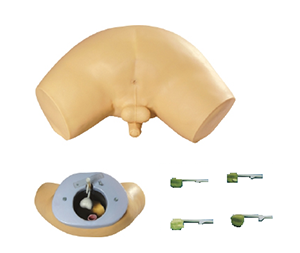Welcome to visitShanghai Chinon medical Model & Equipment Manufacturing Co., LTD
Prostate examinations, especially digital rectal examination (DRE) and prostate-specific antigen (PSA) tests, are the basic methods for diagnosing prostate diseases such as BPH and prostate cancer. However, due to the complexity of the anatomical location and structure of the prostate, doctors may face certain challenges in the examination process, resulting in misdiagnosis or missed diagnosis. Can the prostate examination model, as a high simulation tool, help doctors improve the accuracy of the examination and thus improve the diagnosis rate of prostate diseases? This paper will discuss the clinical significance and data support of prostate examination model based on the views of medical technology and industry experts.
1. Improve the doctor's skill and accuracy

Prostate examination models, especially high-fidelity simulation models, can simulate real prostate anatomy and help physicians train repeatedly in a risk-free environment. This simulation training makes doctors more familiar with the position, size, hardness and other physiological characteristics of the prostate, and improves the accuracy and operation skills of digital rectal examination. Data support shows that the success rate of correctly touching lesions (such as lumps, induration, etc.) is significantly improved and the misdiagnosis rate is reduced by about 30% when doctors who have been trained in simulation perform digital prostatic rectal examination.
2. Promote early diagnosis of prostate cancer
As one of the most common cancers in men, early detection of prostate cancer is crucial for treatment effectiveness and patient prognosis. The prostate examination model can simulate different stages of prostate cancer, including small mass in the early stage and induration in the late stage. Industry experts point out that the simulation model helps doctors improve their sensitivity in early diagnosis, especially when a lump is found during a digital rectal examination. A multi-hospital study showed that doctors trained using a prostate screening model improved detection rates of prostate cancer by 25 percent in early screening.
3. Improve clinical decision-making ability
In addition to the digital rectal examination, the prostate examination model can also help doctors better understand the anatomy of the prostate and related pathological changes, thereby improving the ability to judge complex conditions. In some complex cases (such as prostate hyperplasia with malignant tumors), the doctor needs to consider multiple diagnostic factors at the same time. By replicating complex cases, simulation models help physicians improve decision-making speed and accuracy in dynamic environments. Studies have shown that trained doctors take an average of 15 percent less time to make a diagnosis in complex cases.
4. Enhance doctor-patient communication and patient experience
Prostate exams, especially digital rectal exams, are often uncomfortable or embarrassing for patients. By using the prostate exam model, doctors can improve the fluency of the procedure and the comfort of the patient through simulated practice, thus reducing the discomfort of the patient. This can not only improve the smoothness of the examination, but also improve the patient experience. The data analysis showed that the doctors who received the simulation training had higher satisfaction in the process of patient visits, and the patient complaint rate was reduced by more than 20%.
5. Clinical significance and wide application
The clinical significance of prostate examination model lies in the fact that it can provide a standardized and systematic training method, especially for medical novices and young doctors. Experts believe that with the development of medical technology, simulation training will become an integral part of medical school and hospital training. The use of the model can not only improve the technical level of doctors, but also improve the overall health management level of patients by reducing misdiagnosis and missed diagnosis.
conclusion
By providing a highly simulated training platform, the prostate examination model helps to improve the doctor's operational accuracy and decision-making ability, especially in the digital rectal examination and the early screening of prostate cancer. The data and the support of industry experts show that the prostate examination model can effectively improve the accuracy of the examination, reduce the misdiagnosis rate, improve the patient experience, and then have significant application value in clinical practice. Therefore, the popularization and application of prostate examination model is of great significance for improving the early diagnosis rate and medical quality of prostate diseases.
|
NEXTпјљWhy is the central venipuncture intubation model a key tool in first aid skills training?
LASTпјљCan male pelvis model improve pelvic anatomy learning in medical education? |
Return list |